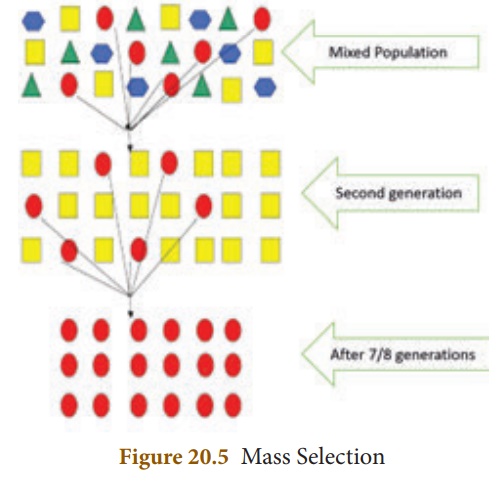Chapter: 10th Science : Chapter 20 : Breeding and Biotechnology
Methods of Plant Breeding for Crop Improvement
Methods of Plant Breeding for Crop Improvement
Methods of plant
breeding to develop high yielding varieties are given below:
1.
Introduction of new varieties of plants
2.
Selection
3.
Polyploidy breeding
4.
Mutation breeding
5.
Hybridization
1. Introduction of New Varieties of Plants
It is a process of
introducing high yielding varieties of plants from one place to another. Such
plants are called as exotic species. These imported plant materials may
carry pathogens and pests, hence they are thoroughly tested in a plant
quarantine before being introduced to the fields. e.g Phaseolus mungo
was introduced from China.
2. Selection
Selection is one of the
oldest methods of plant breeding in which individual plants or groups of plants
are sorted out from a mixed population based on the morphological characters.
Methods of selection
There are three methods
of selection. They are
1.
Mass selection
2.
Pureline selection
3.
Clonal selection
1. Mass selection
Seeds of best plants
showing desired characters are collected from a mixed population. The collected
seeds are allowed to raise the second generation. This process is carried out
for seven or eight generations. At the end, they will be multiplied and
distributed to the farmers for cultivation.
Some common examples for
mass selection are groundnut varieties like TMV–2 and AK–10. Its schematic
representation is given below.

2. Pureline selection
Pureline is “the progeny
of a single individual obtained by self breeding”. This is also called as
individual plant selection. In pureline selection large numbers of plants are
selected from a self-pollinated crop and harvested individually.![]()
![]()
Individual plant
progenies from them are evaluated separately. The best one is released as a
pureline variety. Progeny is similar both genotypically and phenotypically.
3. Clonal selection
A group of plants
produced from a single plant through vegetative or asexual reproduction are
called clones.
All the plants of a
clone are similar both in genotype and phenotype. Selection of desirable clones
from the mixed population of vegetatively propagated crop is called clonal
selection.
3. Polyploidy Breeding
Sexually reproducing
organisms have two complete set of chromosomes in their somatic cells. This is
called diploid (2n). The gametic cells have only one set of chromosome.
This is called haploid (n). An organism having more than two sets of
chromosomes is called polyploid (Greek : Polys = many + aploos = one
fold + eidos = form). Such condition is called Polyploidy. It can be induced by
physical agents such as heat or cold treatment, X-rays and chemical
agents like colchicine.
Achievements of polyploidy breeding
Some achievements of
polyploidy breeding are
a. Seedless watermelons (3n) and bananas (3n).
b. TV-29 (triploid variety of tea) with larger shoots and drought
tolerance.
c. Triticale (6n) is a hybrid of wheat and rye. To make this plant
fertile polyploidy is induced. It has higher dietary fibre and protein.
d. Raphano brassica is an allotetraploid by
colchicine treatment.
4. Mutation Breeding
Mutation is defined as
the sudden heritable change in the nucleotide sequence of DNA in
an organism. It is a process by which genetic variations are created
which in turn brings about changes in the organism. The organism which
undergoes mutation is called a mutant.
The factors which induce
mutations are known as mutagens or mutagenic agents. Mutagens are of two
types namely physical mutagens and chemical mutagens.
i Physical mutagens
Radiations like X-rays,
α, β and γ-rays, UV rays, temperature etc. which induce mutations are called
physical mutagens
ii Chemical mutagens
Chemical substances that
induce mutations are called chemical mutagens. e.g. Mustard gas and nitrous
acid. The utilisation of induced mutation in crop improvement is called mutation
breeding.
Achievements of mutation breeding
Some achievements of
mutation breeding are
a. Sharbati Sonora wheat produced from Sonora-64
by using gamma rays.
b. Atomita 2 rice with saline tolerance
and pest resistance
c.
Groundnuts with
thick shells
5. Hybridization
Hybridization may be
defined as the process of crossing two or more types of plants for bringing
their desired characters together into one progeny called hybrid. Hybrid
is superior in one or more characters to both parents. Hybridization is the
common method of creating genetic variation to get improved varieties.
Hybridization Experiment: Triticale (The first man – made cereal)
Triticale is the first man- made
cereal hybrid. It is obtained by crossing wheat (Triticum durum,
2n = 28) and rye (Secale cereal, 2n = 14). The F1 hybrid
is sterile (2n = 21). Then the chromosome number is doubled using
colchicine and it becomes a hexaploid Triticale (2n = 42).
The cycle of crop
raising and selection continues till the plants with the desired characters are
finally obtained. The development of new varieties is a long-drawn process. Two
main aspects of hybridization are to combine the characters of two plants in
one plant and to utilize hybrid vigour.
Related Topics